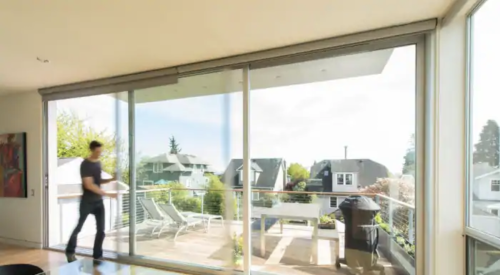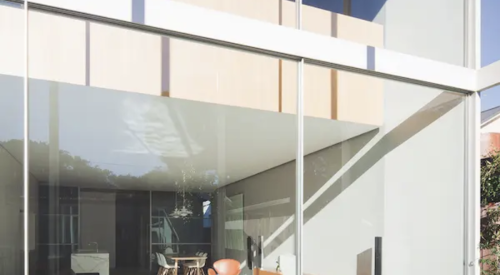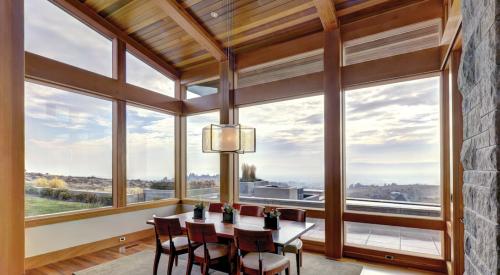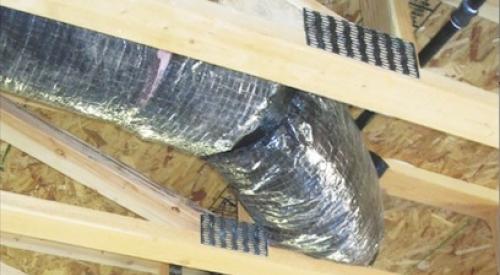 |
This Craftsman-style door is from Jeld-Wen's collection of custom composite exterior doors. These doors feature all the beauty of hardwood doors without the maintenance. They are available in a variety of designs, including many with character marks and knots to simulate the distinctive appearance of genuine wood. This model (above) has a mahogany finish and sidelights. |
 |
 |
Masonite's Barrington® features a variable-depth, wood-grain texture that delivers an authentic hardwood door appearance. All Barrington doors feature square-edge construction, polyurethane cores, and triple-pane insulated decorative glass for true wood door aesthetics and maximum performance. |
 |
Weather Shield Entry Doors offer the look of wood in a low-maintenance fiberglass door. |
 |
 |
Pella offers a fiberglass entry door that looks like wood, as seen here with Francesca glass. |
If there were a way to increase a home's value by up to six percent, most builders would rush to learn how. One answer lies in paying attention to the entry door, according to the National Home Valuation Study, recently conducted.
"Why build a house without a beautiful front entrance? It doesn't make sense," says Dave Koester, brand manager for Weather Shield Windows & Doors.
Nevertheless, not all builders heed this advice. "Builders don't typically think of entry doors as a profit center," says Todd Friedman, marketing manger for Pella Entry Systems. "But when they use quality products, backed by a reputable brand, entry systems can help add value to the home and to its overall profit potential."
Fiberglass versus Wood
"Today's models are definitely not your father's entry door," says Koester. He points to the trend toward fiberglass doors versus those made of steel or wood. "Wood doors can decay, chip and expand; steel doors can rust or dent; but fiberglass doors are impervious to all these problems. Also, with the wild fluctuations in steel prices, primarily driven by the building boom in China, fiberglass doors are a terrific value."
John Kufner, product line general manager/entry door systems for Therma-Tru Doors, agrees: "By 2000, fiberglass doors had 10 percent of the market share, most of that gained from wood and steel entry doors. Today, fiberglass has nearly 14 percent of the market and is predicted to grow nearly 30 percent by 2007."
That's all true, but the bar has been raised, according to Lawrence P. Repar, executive vice president and group chief operating officer for Masonite International Corporation. "Composite products must not only provide excellent performance, they must also be very realistic or authentic in appearance."
When only wood will do, the trend is toward the unusual. "We see more exotic wood species, such as cherry and mahogany," says Ann Mayer, marketing communications coordinator for Kolbe & Kolbe Millwork Co., Inc. "Personalized doors are in high demand; people want something that will make their home stand out."
Personalization Equals Profits
Whether made of wood or fiberglass, the door must say something about the home and its owners. "Traditionally, builders offer a solid door with a couple of clear glass sidelights," says Pella's Friedman. "Yet, consumers want upgraded door and glass designs to personalize their home."
Personalization is not always easy to offer, especially when buyers wait until the last minute to make their choices. However, manufacturers are trying to help builders offer customization without all the headaches. Pella, for one, is working to simplify the entry system-selection process by offering documentation that shows the standard door plus up to five upgrades.
Similarly, Weather Shield provides a number of configurations, including decorative glasses, seven hardware finishes, 11 interior trim styles, numerous pre-finished color options and much more - all with a very short lead-time. Says Koester, "This really helps builders deal with homeowners who are intent on waiting until the last possible moment to decide on an entry door."
Creating personalized entrances is a wood door's strong suit, as evidenced by the growing popularity of rustic wood entrances. "Rustic living is in high demand," reports Kolbe & Kolbe's Mayer. "Douglas fir, knotty alder, and knotty pine timbers are all hot commodities, no matter if you live in Los Angeles or the Rocky Mountains. More people want to get back to nature, without the hours of travel, so they choose to bring the natural rustic look into their city and town homes."
Shane Meisel, marketing manager at Jeld-Wen, suggests that the most significant trend is having everything new look old. "The trend for homes to mirror a more traditional look, such as the Tuscan/Mediterranean style, can be attributed to an increase in travel to Europe," he says. "We are also seeing a resurgence in Craftsman-style entry doors, which hearkens back to the new American architecture of the turn of the 19th century. But whatever the style, homeowners are looking for a grand entry system that exhibits the sophistication of age."
Make a Grand Entrance
Creating a grand entrance contributes considerably to that first impression, and that has translated to size. "Entry doors have become larger - eight-feet or taller, often with double doors," says Jeff Kibler, Peachtree brand manager for Peachtree Doors & Windows. "They have also become more elaborate, as homeowners' tailor the invitation to their homes. No longer is an entry just a door. It's a door, plus sidelites, transoms or huge fixed windows above."
"The small, quaint doors of yesteryear are no longer the norm," seconds Kolbe's Mayer. "Back then eight-foot ceilings was standard, but today's standard is 10 feet, allowing homeowners to place larger door units into the overall design of their homes."
Understanding Performance
There are a large number of entry door brands and materials that might seem similar, but perform very differently. "Builders need to choose door systems that not only fit their construction budgets, but also withstand the rigors of construction and perform for years without callbacks," says Therma-Tru's Kufner.
Sounds easy, but it's not, according to Kufner, who adds: "It's hard to tell the true performers from the copycats without understanding the construction, testing and performance criteria for the doors in question."
"Many builders buy simply based on price, which usually gets a low-quality steel door that may or may not hold up well to water and wind," notes Pella's Friedman. "Often, the jambs and sills on low-priced options are susceptible to deterioration. Builders should look at the lifecycle cost of the product. They need to consider the material and its ability to withstand the construction process, as well as the maintenance requirements for the homeowner. Using a high-quality entry system from the start will help eliminate the costly callbacks that eat into a builder's profits and, potentially, his reputation."
Weather Shield offers entry doors with sidelites as an all-in-one unit with a continuous head and sill - whether there's one sidelite or two. This provides greater stability and easier installation, because the units aren't individually mulled together, according to Koster. Weather Shield has also redesigned all its entry doorsills to provide a new composite sill that, unlike wood, resists swelling and rotting.
"The new sill design lifts the jamb off the ground and onto the composite sill, preventing trapped water from damaging the jamb," Koster explains. "An internal weep system helps channel water away from the door to further reduce potential moisture damage. These changes offer the ultimate in durability."
There is little dispute that wood doors need yearly maintenance to keep their character, but if maintained properly, they will last for years. Nevertheless, some people want a true wood door with little or no maintenance. For these buyers, Kolbe Windows & Doors offers an extruded aluminum, raised-panel door. This model reduces exterior maintenance while offering the natural beauty of a wood door on the interior.
Peachtree markets a smooth-exterior/textured-interior, fiberglass entry door that delivers the look of wood inside. Outside, there's a high-performing non-rot sill; a single-frame system for the door panel; sidelites; a rectangular transom; and aluminum-clad exterior frames. Kibler suggests this door offers the best of both worlds: inside, the look of wood without the maintenance; outside, a smooth, low-maintenance exterior.
Masonite has also launched two new lines of fiberglass entry doors: Belleville™ and Barrington®. The former features a high-definition panel profile, traditional and unique designs, and smooth and textured surfaces. The Barrington offers high-definition raised molding, unique designs, and factory-glazing with a choice of custom or decorative glass. Both doors feature Masonite's variable-depth wood-grain texture, square-edge construction and polyurethane cores for true wood door aesthetics and maximum performance.
Not to be outdone, Jeld-Wen offers Aurora Custom fiberglass doors. They "are like no other fiberglass door on the market," remarks Meisel. "They are visually indistinguishable from a true wood door and provide the maintenance-free performance of fiberglass." The Aurora Custom Fiberglass doors are available in many different design styles, including Old World and Craftsman, and come with oak, mahogany, and knotty alder wood grains.
The Bottom Line
The biggest mistake builders make when choosing an entry door, Peachtree's Kibler suggests, "is basing their decision on price rather than aesthetics or the potentially higher margins that can be built into doors with decorative and maintenance-free features.
"Builders too often forget that entries add curb appeal and increase a home's salability," he continues. "It's the home's 'invitation' to the world. Who would put a wedding invitation on newsprint?"
Kibler acknowledges that "builders are rushed for time. They tend to be slow to adopt new technology - not for lack of knowledge, but because they don't have time to research new products.
It may take some effort, but investing time in exploring the options can pay off. "A basic panel is fine for garage entries or back doors, but builders should give more attention to the front door," Kibler continues. "Homeowners are often willing to pay a premium for options and accessories."
Masonite's Repar concurs: "We have found that if the options are offered, consumers will buy. Upgrading the entry door is a very economical way to upgrade the appearance of the home.
In research conducted with NFO Worldwide, Therma-Tru found that its fiberglass entry system can add as much as $24,000 to a home's perceived value, "which is approximately five times the cost of the entry system," states Kufner. Jeld-Wen's Meisel suggests the profit is even higher. "Research has shown that an entry door can change the perceived value of a home by more than $30,000," he comments.
Builders can increase their profitability with entry doors in two ways, concludes Pella's Friedman. "The first is by investing in a quality brand that helps add value to a home; the second is by offering homeowners a choice. Homeowners are willing to invest in quality entry door systems to add value to their homes and their lives to express their own personal sense of style."












